This method of tinting a car today is a technological novelty. Thanks to it, the comfort of passengers during the trip is significantly increased. In addition, the vehicle is now much better to manage.
Naturally, the level of the convenience of the car is affected by a number of other important factors, such as the quality of the suspension, the total technical equipment of the vehicle, the height of the engine landing, etc. But only thanks to the electronic tinting of glasses, the connection of passengers with the surrounding world is created by such a unique, which you can not tell about conventional tint. Both types of this coating provide a decrease in the amount of transmitted light through the glass, but it is the electronic toning that can adjust this parameter in contrast to the usual one.
Content
Normal toning
Dimming the car glass gives an important advantage, since it prevents the penetration of the inside the salon of ultraviolet rays. Due to this, the casing does not fade, and the temperature in the cabin is maintained at a normal level. In addition, tinted glass allows you to limit or completely eliminate the external interior viewing of the car. That is, simply speaking, people on the street will not see who inside the car.
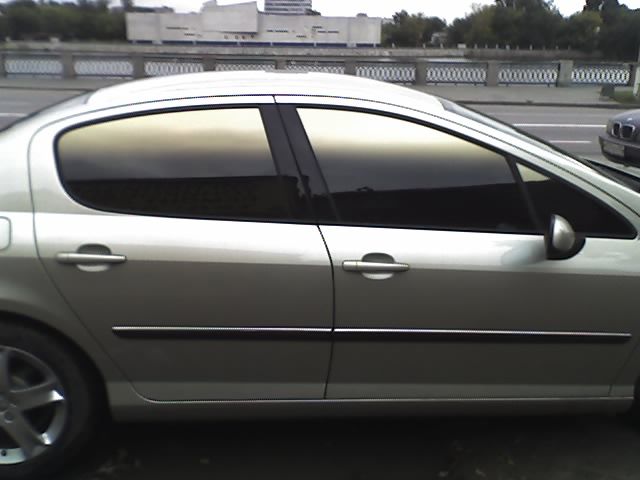
The process of dimming the car's glass is carried out by applying to their surface of a special film or a special composition by spraying, which significantly reduce the glass capacity of the glass.

On the one hand, it is practical and very convenient, but on the other not quite legal. Most of the car owners had to completely remove the tinted coating of glasses after the relevant law adopted by the Parliament, however, not all. As they say, any illegal methods can be done legitimate. We are talking just about electronic tinting of glasses.
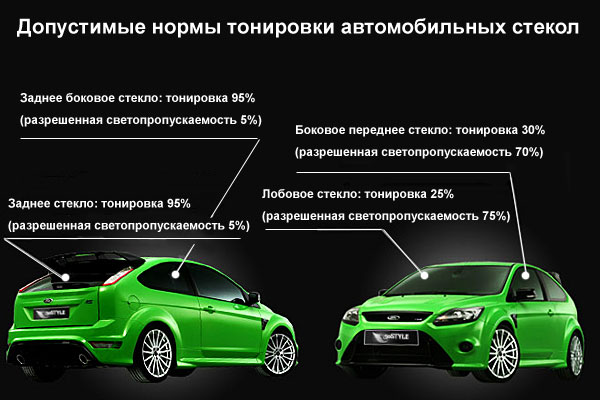
Such glasses are often called "smart" glasses, since their use makes it possible to change the level of glass bandwidth at the request of the owner of the car. This can be done literally in seconds. For example, at night or in cloudy weather, toned glass is characterized by a full bandwidth, and during the daytime it can be adjusted, thereby providing maximum comfort while traveling.
Features of electronic toning
To date, the side and rear windows are not toned and especially the windshield.
Therefore, the electronic tint is applied only on the front side glasses, despite the fact that all automotive glass can be darned.
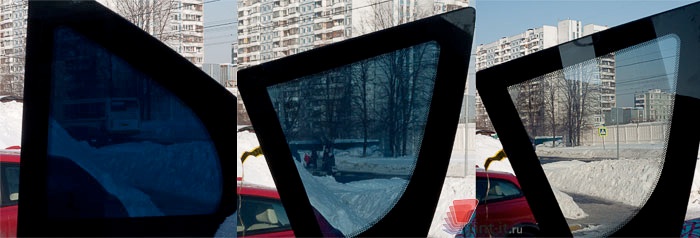
Electrotion of glass includes several elements. Of these, the most basic is a special glass installed on the site of the usual one. It is called smart glass that translated from English means "smart" glass. It is a three-layer structure: the outer two layers are glass, and a special film is placed between them.
There is also such an electronic toning, where there is no need to replace the glass. Here on ordinary glass just glued the film to which the electrical wiring is connected.
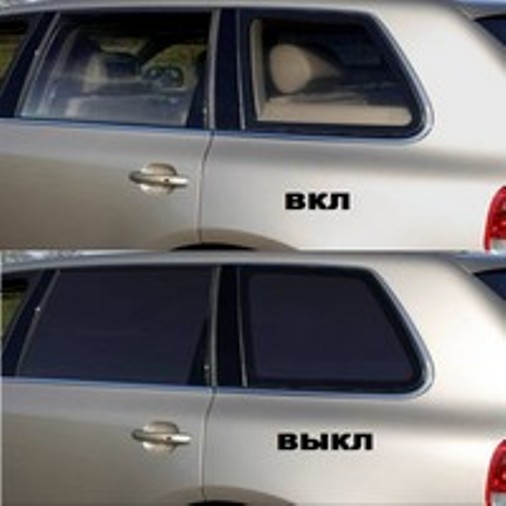
The throughput film capacity directly depends on the voltage value of the electric current. To do this, a special voltage regulator is provided in the chain, thanks to which the glass toning is controlled. The voltage comes from the onboard power supply of the car.
Varieties of electronic tinting
Today there are two types of glass electrotion:
Electronic Toning
The essence of the electron processing process is based on the photoelectric effect: an electric current affects the film liquid crystal structure, due to which the bandwidth of the film can thus be changed.
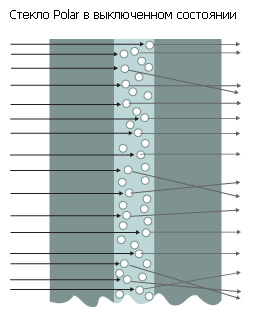
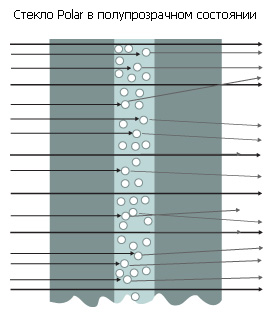
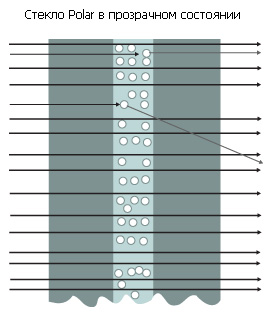
At a time when the electric current is not fed to the film, its liquid crystal structure is in solid form. At the same time, it acquires a matte tint and as a result of its bandwidth equals zero.

When the current is again fed to the film, this layer goes into the molten state and in turn its throughput increases again.

With the maximum value of the supplied voltage, the glass becomes completely transparent.
electrochromic toning
This type of electronic toning is based on the same principle as the previous one. The whole difference consists in the film used. In electrochromic toning, a polymer film is used.

These substances change their optical characteristics under the action of electric current, the level of illumination and external air temperature.
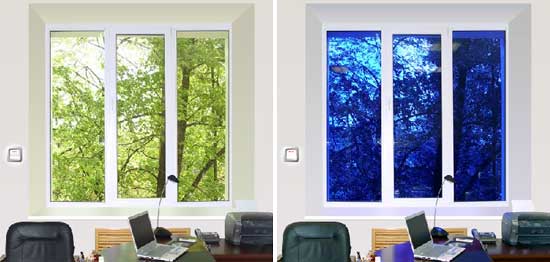
As well as the liquid crystal film, it is either glued to the surface of ordinary glass, or include a three-layer "smart" glass.
Types of electrochromic toning
Today there are two types of electrochromic tinting of automotive glass: SPD and PDLC.
In the process of toning, polymers are used in the first way in the film composition, thanks to which the capacity of the glass is reduced, and its transparency.
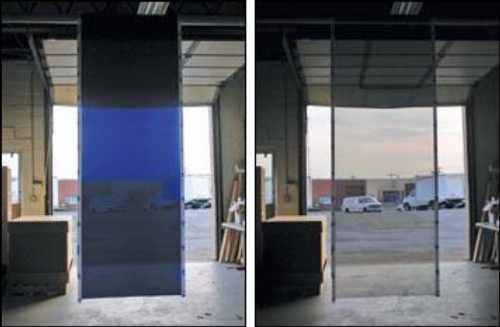
Electrochromic toning by the PDLC method is to apply such a polymer film that is capable of changing only the level of its transparency, but not transmissibility remaining unchanged. Under the influence of electric current, the polymers in the film are becoming matte, so it is not visible from the street who is in the car's cabin and what happens in it. At the same time, the sun's rays go inside the interior fully.
The practicality of both types of glass tinting is that there is no need to provide a constant supply of electric current, only with the need to change the dimension of the car's glass.
In the case of using smart glasses, you just need to install them correctly instead of usual. In addition, it is necessary to ensure proper power supply and connection to the onboard automotive network.
If only the film is used, it is necessary to glue it on the glass strictly according to the technology, otherwise it can be spoiled. After successful adhesion, it is necessary to ensure the correct connection of all items in the kit.
Advantages and disadvantages
Electronic tinting of glasses has many important advantages. One of the most important things is the lack of anxiety that you can become fined somewhere on the road, because at any moment you can make the glass transparent.

In addition, when using electronic tinting, you can always change and thereby adjust the level of the dimension of glasses under current weather conditions. Even if the glasses are completely transparent, toning will still prevent ultraviolet rays from entering the car's interior.
As for the shortcomings, it is only one here is a high cost of tinting. This is explained by an individual approach to each client, which is much more expensive, first of all, in time, compared with mass maintenance.
The total cost of all works depends on the number of glasses by car on which electronic tinting and their area will be produced. Including material, it will cost from 3 to 10 thousand dollars.
Making a conclusion, it can be said that the electronic toning is a very progressive method of dimming glass, thanks to which each passenger in the car can feel as comfortable as possible and at the same time not to worry about the violation of the law. But at the moment it is not all for the pocket.
Related Materials
- Stove 2110, bad warm stove 2110, VAZ 2110 heating system, repairing the heating system VAZ 2110 with their own hands
- VAZ 2114 stove blows with cold air, stove 2114, bad warm stove VAZ 2114, device and repair of heating VAZ 2114 do-it-yourself, removing the stove VAZ 2114
- How to subdominize the car. How to put a jack. Types of jacks for cars.
- VAZ 2109 Fuse Block, VAZ 2109 Fuse Block Carburetor, VAZ 2109 Fuse Block Injector, Old VAZ 2109 Fuse Block, VAZ 2109 Fuse Block, VAZ Fuse Block 2109
- Car exhaust gas catalyst, faulty catalyst, pluses and cons of the catalyst, how to change the catalyst for the planeencitel
- Stove blowing cold air VAZ 2114, badly blowing the stove VAZ 2114, why badly blowing the stove VAZ 2114
- How to find out the owner of the car by the number of his car, check the car by the number of the traffic police machine, check the car by the state number of the car for free
- How to choose Used tires, Useful Tips
- Winter car road, pressure in passenger car tires in winter, good battery for the car in winter, whether to warm the car in winter
- In winter, the car is poorly started. How to make a car in winter, do you need to warm up the car in winter, useful tips
- Economy fuel consumption machines, the most economical car consumption
- Tires brands for passenger cars, labeling of car tire labeling, residual passenger car tire protector, how to pick a tire on a car brand, car tire tread pattern
- Working transmission operation, mechanical gearbox clutch work, driving with manual gearbox, useful tips
- Rear beam Peugeot 206 sedan, rear beam device Peugeot 206. Rear beam Peugeot 206 Malfunction, repair of the rear beam Peugeot 206
- Diesel fuel in winter, additive for diesel fuel in winter, how to choose the best diesel fuel
- Diesel winter does not start. How to start diesel in winter, heating diesel in winter.
- Japanese bridgestone tires, winter studded bridgestone tires, bridgestone tires brand
- Tire marking decoding for passenger cars, labeling wheels, how to choose the right tires on the disks
- Diesel engine in winter, launch of the diesel engine in winter, what oil to fill in a diesel engine in winter, useful tips
- LED backlight of the car, the backlight of the bottom of the car, the backlight of the legs in the car, the backlight in the door of the car, the backlight of the car is fine
- Recovered tires, bus tire, restored tire protector, can I use them
- Choose winter tires, which is a winter tires, which pressure in winter tires should be marked with winter tires, how to choose the right winter tires, the best winter tires 2019
- Steering rail rail, knock of steering rack, reasons for the knock and repair of the steering rack do it yourself
- Cameless car tires, a set for repair of tubeless tires, repair of the cannon-free tire do it yourself
- Russian tires, Russian tires Winter, Russian All-season tires, Voronezh AMTEL tires, Tires "Matador Omsk Tire", Kama-tires are world-class bus
- How to open a car without a key. Lost the key from the car what to do, the key from the car inside the car
- Silent tires, quiet winter tires, quiet studded bus, which tires to choose, overview tires
- Rules of safe driving of the car in the rain and slush, safe driving of the car for beginners
- Rust converter which is better for cars, rust converters to choose how to use rust transducer, professionals
- Polishing the body of the car do it yourself, how to choose a polishing paste, useful tips
- Engine durability, engine life, how to extend engine life
- Knock in the car. Knock when moving the car. What can knock in the car. How to determine the cause of the knock.
- ABS car, what is ABS car, ABS system malfunction, ABS diagnostics
- Overtaking a car when you can start overtaking a car, rules of traffic rules
- Fuel pump VAZ 2110, VAZ 2110 gas station scheme, VAZ 2110 fuel pump device, VAZ 2110 gas station repair,
- Automotive antennas for radio, automotive antenna device, car antenna do it yourself
- Front suspension Kalina, device front suspension Kalina, knock in front suspension Kalina, repair of front suspension Kalina
- Shock absorber Oil, best oil shock absorbers, pumping oil shock absorbers, how to properly pump oil shock absorber
- Clutch malfunctions, touches clutch, causes a clutch malfunction, how to eliminate
- Viscounts of the fan, work uniforms of the fan, malfunction of the ventilator fan, repair of the ventilator fan
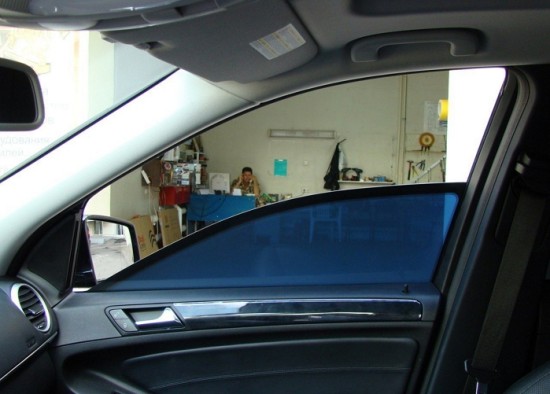






Comments